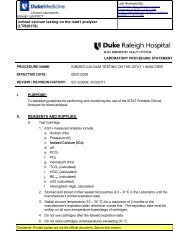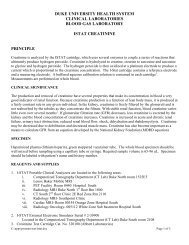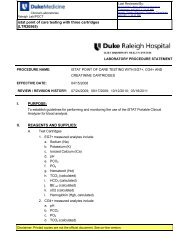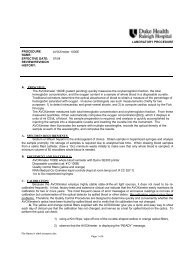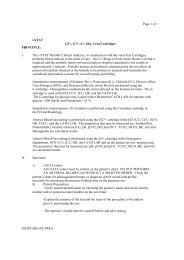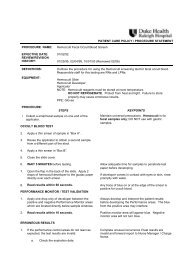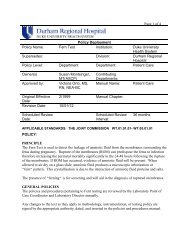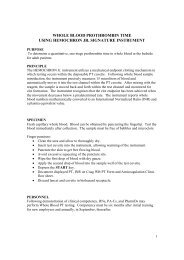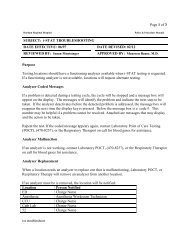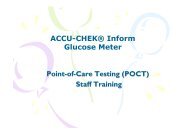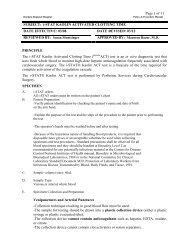DUKE UNIVERSITY HEALTH SYSTEM - Point of Care Testing ...
DUKE UNIVERSITY HEALTH SYSTEM - Point of Care Testing ...
DUKE UNIVERSITY HEALTH SYSTEM - Point of Care Testing ...
Create successful ePaper yourself
Turn your PDF publications into a flip-book with our unique Google optimized e-Paper software.
<strong>DUKE</strong> <strong>UNIVERSITY</strong> <strong>HEALTH</strong> <strong>SYSTEM</strong>BLOOD GAS LABORATORYActivated Clotting Time Using the Hemochron Signature ElitePURPOSEACT Plus (ACT +)The Hemochron Elite ACT+ is a quantitative assay for monitoring heparin anticoagulation duringvarious medical procedures. The Hemochron Elite ACT+ assay demonstrates a linear correlationto the anticoagulation effects <strong>of</strong> heparin between 1.0 and 6.0. It is intended for use inmonitoring moderate to high heparin doses frequently associated with procedures such ascardiopulmonary bypass surgery, i.e. 30,000 U <strong>of</strong> heparin (depending on the patients weight).The ACT+ is not sensitive to very low levels <strong>of</strong> heparin such as those encountered in criticalcare. The ACT+ test is for in vitro diagnostic use and is for use with the Hemochron Elite WholeBlood Microcoagulation System.ACT Low Range (ACT -LR)The Hemochron Elite Low Range Activated Clotting Time (ACT-LR) is a quantitative assay formonitoring heparin anticoagulation during various medical procedures. The Hemochron EliteACT-LR assay demonstrates a linear correlation to the anticoagulation effects <strong>of</strong> heparin at doesup to 2.5 units/cc <strong>of</strong> blood. It is intended for use in monitoring low to moderate heparin dosesfrequently associated with procedures such as cardiac catherization, Extracorporeal MembraneOxygenation (ECMO), hemodialysis and Percutaneous Transluminal Coronary Angioplasty(PTCA) i.e. 5,000 U <strong>of</strong> heparin (depending on the patients weight). The ACT-LR test is for in vitrodiagnostic use and is for use with the Hemochron Elite Whole Blood Microcoagulation System.This procedure is intended for use by units with ACT target values <strong>of</strong> less than 400 seconds.PRINCIPLE:The Hemochron Signature Elite cartridges utilize a mechanical endpoint clotting mechanism inwhich testing occurs within the disposable ACT cuvette. Following whole blood sampleintroduction, the instrument precisely measures 15 microliters <strong>of</strong> blood and automaticallymoves it into the test channel within the ACT cuvette. The remainder <strong>of</strong> the blood sample, notneeded for testing, is automatically drawn into the waste channel <strong>of</strong> the cuvette.Sample/reagent mixing and test initiation are performed automatically, requiring no operatorinteraction. After mixing with the reagent (kaolin), the sample is moved back and forth within
the test channel and monitored by the analyzer for clot formation. The clot detectionmechanism consists <strong>of</strong> two LED optical detectors aligned with the test channel <strong>of</strong> the cuvette.The speed at which the blood sample moves between the two detectors is measured. As clotformation begins, blood flow is impeded and the movement slows. The instrument recognizesthat a clot endpoint has been achieved when the movement decreases below a predeterminedrate. Electronic optical detection <strong>of</strong> a fibrin clot in the blood sample automatically terminatesthe test. The instrument’s digital timer displays the Celite® equivalent ACT value in secondsEQUIPMENTMATERIALS/REAGENTS:I. Equipment:A. Hemochron Signature Elite Microcoagulation Instrumenti. Description:The HEMOCHRON Signature Elite instrument is a hand-held device. It contains a test chamberwhich warms a test cuvette to the required temperature, and it performs all operations tomeasure the clotting time <strong>of</strong> a whole blood sample after it is placed in the test cuvette and thetest is started by the operator.Operator instructions are shown on the display panel, and the operator enters commands andinformation using the keypad. When the test is completed, the results are shown on the displaypanel and stored in system memory for printing or downloading.________________display panel________________Keypad with number and actionkeys________________Test chamberThe operating environment for the Elite should be between 15C to 30C (59F to 86F). Theinstrument includes a barcode scanner for reading <strong>of</strong> barcode labels.
CANCELCancel an operation and return to the previous state.ENTERAccept an entry (e.g., a Patient ID, an Operator ID, a time, or a date).Display PanelThe instrument communicates with the operator by means <strong>of</strong> the display panel. For example,Add Sample and Press Start are alternately displayed after a test cuvette reaches temperature:The display is illuminated to enhance visibility in low light conditions. To conserve power duringbattery operation, the display is not illuminated when the test well is empty or when a test isrunning. The display is momentarily illuminated after a key is pressed or when results <strong>of</strong> acompleted test are displayed. While a test is running, the display can be momentarilyilluminated by pressing the CANCEL key, the ENTER key, or any numeric key.MenusThe action keys are used to display and activate various commands for operating andconfiguring the system. The principal menus are shown below:MenuMain MenuAccessPress the 0 (zero) key when no tests are running and no othermenu isConfigurationMenuPress the 6 key while the Main Menu isdisplayed.
Supervisor MenuPress the 5 key while the Configuration Menu is displayed,enter the supervisor PIN at the prompt, then press andhold the Enter keyPrint Options MenuPress the 6 key while the Supervisor Menu is displayed.Communications MenuPress the 7 key while the Supervisor Menu is displayed.QC Selects MenuPress the QC key while a cuvette is inserted in theinstrument.QC Status MenuPress the QC key before a cuvette is inserted in theinstrument (or, select 4 from the QC Selects menu.)
Notes MenuPress the NOTE key after a cuvette is inserted in theinstrumentID Selects MenuPress the ID key while a cuvette is inserted in theinstrument.Print/ScanMenu 1Press the PRINT/SCAN key.Print by PatientMenuPress the 4 key while the Print Menu 1 is displayed.Print by QCMenuPress the 5 key while the Print Menu 1 is displayed.Print/ScanMenu 2Press the 7 key while Print Menu 1 is displayed
Database MenuPress the DATABASE key.Execute a command on a menu by pressing the action key for that command. For example, ifthe Main menu is displayed, press the 4 key to shut down the system, or press the 5 key todisplay systeminformation.Note: The main menu cannot be accessed if a cuvette is in the test well. If a cuvette is used toturn on the instrument, it must be removed to access the main menu.B. Transformer (optional): 9 volt supplied with Signature+ instrument; 12 volt supplied withSignature Elite instrument.IIMaterials/ ReagentsInternational Technidyne Corporation (ITC) Hemochron Signature Elite ACT WholeBlood Coagulation SystemACT Reagent Cuvette (ITC ACT+ Cuvette) Material # JACT + ACT. Each box contains45 cuvettes.ACT Quality Control Material Direct Check: Normal – Material # DCJACT-NACT Quality Control Material Direct Check : Abnormal – Material # DCJACT-A ACT Reagent Cuvette (ITC ACT-LR Cuvette) Material # JACT –LR. Each box contains 45cuvettes.ACT Quality Control Material Direct Check: Normal – Material # DCJLR-NACT Quality Control Material Direct Check: Abnormal – Material # DCJLR-AEach box is stamped with a lot specific expiration date and labeled with a QCchecked label.Cuvettes are good for 3 months at room temp
Controls are stable for 1 month at room tempAppropriate syringe for sample collectionWARNING:Must be labeled with an opened date and an expiration dateSpecimen Type, Collection and Handling CriteriaThe Hemochron Elite ACT using the ACT+ and LR Cuvette is performed using 0.2 mL <strong>of</strong>fresh whole blood. Samples with any <strong>of</strong> the following characteristics should bediscarded immediately, and a fresh whole blood sample collected prior to performingany test on the Hemochron instrument. The following characteristics may interferewith the ACT assay.Sample contamination with tissue thromboplastinSample contamination with indwelling intravenous (I.V.) solutionsSample contamination with alcohol cleansing solutionSamples with visible clotting or debris accumulationBlood samples to be used for coagulation testing must be collected according to thefollowing procedures to assure the integrity <strong>of</strong> the fresh whole blood sample.1. Syringe sample, from indwelling venous bloodlineWARNING:Do not obtain blood from heparinized access line, lock, or indwellingheparin lock:Note: The amount <strong>of</strong> blood required to adequately flush the line until it is free <strong>of</strong>contaminants is dependent on the amount <strong>of</strong> solution contained within theline. A typical heparin lock will require approximately 5.0 mL to clear the line.Greater volumes will be required to clear longer lines.a. Discontinue fluids drip, if required.b. Using a 5 mL syringe, collect a minimum 1 mL <strong>of</strong> fresh whole blood from apreviously flushed access port.c. From the collection syringe, immediately dispense a drop <strong>of</strong> blood into theSignature Elite cuvette.d. Immediately press start to perform the test.2. Syringe sample, from a venipuncturea. Prepare the venipuncture site by cleansing with alcohol and allowing to air drycompletely.
. Using a two-syringe technique, fill the first syringe with 2.0 mL <strong>of</strong> blood anddiscard.c. Obtain a minimum 1.0 mL <strong>of</strong> blood with the second syringe.d. Immediately dispense a drop <strong>of</strong> blood into the Signature Elite cuvette.e. Immediately press start to perform the test.3. Extracorporeal blood line porta. Flush the extracorporeal bloodline by withdrawing and discarding 5 mL <strong>of</strong> blood.b. Obtain a 1 mL sample with a second syringe for testing.c. Immediately dispense a drop <strong>of</strong> blood into the Signature Elite cuvette.d. Immediately press start to perform the test.Patient <strong>Testing</strong> ProcedureNote: The ACT+ Test Cuvette must be allowed to come to room temperature prior touse.Blank (<strong>of</strong>f)Analyzer ScreenFlashes Insert……..Cuvette…….Enter OID SCAN onlyEnter PIDActionPress and hold START key for 1 second to turn on theanalyzerRemove cuvette from foil pouch and insert in right side <strong>of</strong>analyzer until you hear it click into place. The printed labelon the cuvette should face up. Select correct lot numberfrom list.Enter ID by pressing Print/Scan button and holding thebarcode <strong>of</strong> your ID 1 – 2 inches from the infrared scanner(located on the top edge above the number 3 key. Your IDcan be entered ONLY by scanning in this manner. Your IDwill not work if you have not been properly trained andentered into the database. Screen will show “STORED”when ID is accepted.Enter the patient ID number and press and hold the ENTERkey (about 1 second). The patient ID must be the entirepatient medical record number (INCLUDING check digit butexcluding leading zeros) with no spaces or dashes. Screen
Analyzer ScreenActionwill show “STORED” when ID is accepted.……Warming…….Warming……Countdown m:ssAdd Sample……. Press StartLoading Sample....RemovingWaste….Result displayedTo download results:Analyzer is preparing for sample. DO NOT add sample untilprompted to do so by the analyzer. The instrument isready when you hear an audible beep and the Add Samplemessage appears.Immediately add 1 small drop <strong>of</strong> sample to the cuvette andpress START. Sample must be fully added to cuvetteBEFORE Start is pressed.**see note below regarding dropsize.You should see the sample begin to migrate into thecuvette.Once finished, the meter beeps once and displays thepatient result.Connect instrument via Ethernet cord to the assigned port(on the left side <strong>of</strong> the instrument on the top row). Pressthe database button. Press ‘6’ to transmit the results.Note: The size <strong>of</strong> the drop is very important. Too little or too much sample will causean error message. The sample well should be evenly full, that is, it should notform a dome that rises above the edge <strong>of</strong> the sample well. If too much sample isadded it may be removed prior to pushing START by rubbing a finger across thetop <strong>of</strong> the sample well to push the dome <strong>of</strong>f into the overflow area. Appropriatesafety precautions must be followed.
Expected Values1. A Note About Celite Equivalent Clotting Time ValuesThe unique ACT+ reagent clots a blood specimen more quickly than thecorresponding Celite reagent. The ACT+ clotting time is displayed as a Celiteequivalent ACT value based on a correlation established in a clinical study. Thelinear regression describing the relationship <strong>of</strong> the two tests has been programmedinto the Hemochron Signature Elite such that the corresponding Celite ACT clottingtime is displayed upon completion <strong>of</strong> the assay.2. A Note About Target ValuesAnalysis <strong>of</strong> the post-heparin bolus clotting time during percutaneous transluminalcardiac angioplasty and cardiac surgery requiring cardiopulmonary bypass indicatesthat the CT+ clotting time may yield target ranges approximately 10% - 15% shorterthan corresponding Celite ACT values. This represents approximately 260 – 270 ACTseconds at a 300 second Celite ACT in percutaneous transluminal cardiac angioplastyand approximately 410 – 440 seconds at a 480 second Celite ACT in cardiac surgeryprior to cardiopulmonary bypass initiation.Institutions must establish their own normal and target anticoagulation ranges andreview them on a regular basis as potentially influencing medications becomeincreasingly used in interventional cardiology and cardiac surgery. Target values atDuke have been established by the Medical Director <strong>of</strong> each area as follows:Area/ CuvetteTarget Ranges
Open-heart surgery with CPB/>480 secondsACT plus (ACT+)ECMO patients/ACT plus (ACT+)Adult Cardiac Cath Lab /ACT Low Range (ACT LR)Peds Cath ablations/160-180 seconds or 180-200 seconds(Dependent on baseline value)> 250 seconds for angioplasty250 secondsACT Low Range (ACT LR)EP Lab RF ablation patients /310-360 seconds (or > 310)ACT plus(ACT+)Method Notes1. Technique variation can alter performance characteristics; care must be taken toadhere to the procedures outlined.2. The temperature <strong>of</strong> the environment in which these tests are performed will affect thecontrol test values obtained.3. When a control is out <strong>of</strong> the expected range after a repeat <strong>of</strong> the control analysis, thecause will usually be one <strong>of</strong> the following:oooTest techniqueControl product is either expired or has been exposed to excessive heat.Test cartridge is either expired or has been exposed to excessive heat.4. All biohazard safety guidelines pertaining to the handling <strong>of</strong> human blood, such asthe CDC guidelines <strong>of</strong> Universal Precautions, should be strictly adhered to whencollecting, handling blood specimens and operating the Hemochron Elite.5. Used Hemochron test cartridges should be considered as potentially infectious. Theyshould be handled according to Duke Hospital’s policies concerning the disposal <strong>of</strong>potentially infectious materials.6. The transfer <strong>of</strong> blood to the ACT test cartridge from a syringe should be performedusing a needleless system.7. The power plug provided should be plugged into an appropriate outlet to charge theinstrument. To unplug the instrument from the power plug, firmly grasp the plug andpull. DO NOT remove the plug from the outlet by pulling on the cord.
8. DO NOT use cartridges past their expiration date or that have been storedimproperly. Cartridges must be properly stored according to the package insert.Recording and Reporting <strong>of</strong> ResultsDue to the nature <strong>of</strong> bedside testing, the results are reported directly to the caregiver.Normally the lab would establish guidelines for critical values and results that fall outsidethe guidelines would be called to the caregiver and so noted in the computer. Thecaregiver would in turn notify the physician. The labs in <strong>Point</strong> <strong>of</strong> <strong>Care</strong> testing are firstexamined by the caregiver so the caregiver can make the determination as to the resultsvalidity, repeat the test, and/or act on it if necessary.There is no Critical Action Value for ACT +. Test results should be scrutinized in light <strong>of</strong>a specific patient’s condition and anticoagulant therapy. Any results exhibitinginconsistency with the patient’s clinical status should be repeated or supplemented withadditional test data.Clinical SignificanceHeparin will prolong the clotting time <strong>of</strong> whole blood by blocking the clot formation atvarious sites in the normal coagulation system, notably that <strong>of</strong> prothrombin to thrombinand fibrinogen to fibrin. Excessive heparin administration can inhibit the clotting cascadesuch that the patient may hemorrhage. After a cardiac stint procedure, patients arerequired to have adequate heparinization and hemostasis before the diagnostic sheathis removed.Limitations <strong>of</strong> the ProcedureThe Hemochron® Elite ACT tests are intended for use in monitoring patients receivingheparin anticoagulation therapy with a heparin concentration <strong>of</strong> more than 1.0 unit <strong>of</strong>heparin/ml <strong>of</strong> blood but less than 6.0 units <strong>of</strong> heparin/ml <strong>of</strong> blood. Celite equivalent ACTvalues exceeding 1005 seconds are not reported on the instrument. Instead an “Out <strong>of</strong>Range – Hi” message will be displayed. Test results greater than 1005 seconds shouldbe considered beyond clinical significance and should be immediately repeated.The Hemochron® Elite ACT-LR test is intended for use in monitoring patients receivingheparin anticoagulation therapy who attain a blood heparin concentration up to 2.5 units<strong>of</strong> heparin/ml <strong>of</strong> blood . Celite equivalent ACT values less than 65 seconds, or over 400seconds are not reported on the instrument. Instead an “Out <strong>of</strong> Range – Lo” or “Out <strong>of</strong>Range-Hi” message will be displayed. Test results greater than 400 seconds should beconsidered beyond clinical significance and should be immediately repeated.The Celite ACT equivalent clotting times expressed for the ACT+ and ACT –LR arebased on the results <strong>of</strong> correlation studies. Linear regression models measure similarity<strong>of</strong> test results between different methods but do not assure identity. Thus, for anysimilarly conducted side by side comparison <strong>of</strong> the ACT+ /ACT-LR and a referenceACT+/ACT-LR , actual differences <strong>of</strong> clotting time may be observed.Samples with a hematocrit less than 20% or greater than 55% are not recommendeddue to an optical density outside the level <strong>of</strong> detection <strong>of</strong> the instruments.
As with all diagnostic tests, Hemochron Signature Elite test results should be scrutinizedin light <strong>of</strong> a specific patient’s condition and anticoagulant therapy. Any results exhibitinginconsistency with the patient’s clinical status should be repeated or supplemented withadditional test data.Hemochron test results are affected byPresence <strong>of</strong> AprotininPoor technique during blood collection, including venipuncture and the testprocedureInadequate specimen/reagent mixing may result in reduced precision and accuracy.Improper storage <strong>of</strong> cartridges such as prolonged exposure to heat outside specifiedguidelinesHemodilutionCardioplegic solutionsHypothermiaPlatelet dysfunctionHyp<strong>of</strong>ibrinogenemia and other coagulopathiesClotted or partially clotted bloodUnsuspected anticoagulation with either heparin or warfarinAbnormal ResultsResults that exceed “1005”or “400” should be considered beyond clinical significanceand the test should be immediately repeated.Results that appear to be inconsistent with patient therapy should be viewed asquestionable and the test should be immediately repeated.CalibrationNot applicable. Hemochron instruments do not require reagent calibration.LinearityPost repair and new analyzers require linearity testing. Linearity testing is performed bythe vendor.Quality ControlRoutine quality control testing and tracking should be a part <strong>of</strong> a comprehensive qualityassurance program. Hemochron Whole Blood Coagulation System Quality Controlproducts are available to make routine QC convenient and affordable. All Hemochroninstruments should be quality controlled at two levels <strong>of</strong> performance, including both the
normal and abnormal ranges. Quality control should be performed once per shift (every8 hours) on any shift during which the instrument is to be used. The manufacturer’squality control protocol is described below.Electronic Quality Control ProcedureThe Hemochron Signature Elite automatically performs internal Quality Control at eighthour intervals if the instrument is plugged in and turned on. If the analyzer is turned <strong>of</strong>fwhen EQC is due, the analyzer will perform EQC when the analyzer is turned on.Electronic Quality Control requires 300 or 500 seconds to perform (depending on testinglocation target values). This should be taken into account when performing a patient testand the analyzer has been turned <strong>of</strong>f. To avoid delays in patient testing, the analyzershould be turned on and allowed to perform EQC well in advance <strong>of</strong> the time whenneeded for a patient test. Patient testing is not allowed until an acceptable EQC isperformed.Quality Control <strong>of</strong> ACT test cartridges (Performed by <strong>Point</strong> <strong>of</strong> <strong>Care</strong> <strong>Testing</strong>Coordinator)Each box <strong>of</strong> Hemochron Signature Elite cartridges contains 45 cartridges from a singlemanufactured lot. The cartridges are lot controlled by the <strong>Point</strong> <strong>of</strong> <strong>Care</strong> <strong>Testing</strong> staff andCentral Distribution personnel. Lot numbers are sequestered and therefore the same lotnumber should be in house for a period <strong>of</strong> 6 months. Upon arrival and prior to beingdispensed for use, two cartridges are removed and validated by <strong>Point</strong> <strong>of</strong> <strong>Care</strong> <strong>Testing</strong>personnel. Validation <strong>of</strong> the shipment is confirmed as long as the results from the newlot number fall within +/-15% <strong>of</strong> the last validated shipment <strong>of</strong> the previous lot number.Subsequent shipments <strong>of</strong> the current lot number must fall within +/- 10% <strong>of</strong> the previousshipment. If results do not fall within these tolerance limits, the shipment should not beplaced into use, and the manufacturer should be contacted. After two cartridges fromeach shipment <strong>of</strong> cartridges has been verified with the QC procedure, that box <strong>of</strong>cartridges should be marked as “VERIFIED”, along with the date <strong>of</strong> verification and theinitials <strong>of</strong> the <strong>Point</strong> <strong>of</strong> <strong>Care</strong> <strong>Testing</strong> Coordinator. This shipment is now “IN CONTROL”and will not require any further investigation until a new shipment <strong>of</strong> cartridges isreceived, unless the cartridges are not stored to manufacturers recommendations orunless a shift in clinical results is experienced.Liquid Quality Control ProcedureEQC (Electronic Quality Control)
EQC (Electronic QC) is performed automatically by the analyzer once every 8 hours.If the analyzer was turned <strong>of</strong>f when EQC was due, it will be automatically performed whenthe analyzer is turned on.EQC takes approximately 8 minutes to run.The operator can also force EQC by pressing the QC button and then pressing the 1 key torun EQC.LQC (Liquid Quality Control)Analyzer ScreenBlank (<strong>of</strong>f)Flashes Insert……..Cuvette…….The ACT+ Test Cuvette AND controls must be allowed tocome to room temperature prior to use.ActionPress and hold START key for 1 second to turn on the analyzerRemove cuvette from foil pouch and insert in right side <strong>of</strong>analyzer until you hear it click into place. The printed label onthe cuvette should face up. Select correct lot number fromlist.Enter ID by pressing Print/Scan button and holding thebarcode <strong>of</strong> your IDEnter OID SCAN onlyEnter PIDQC SELECTSACT+QC Normal (or Abnormal)1 – 2 inches from the infrared scanner (located on the topedge above the number 3 key. Your ID can be entered ONLYby scanning in this manner. Your ID will not work if you havenot been properly trained and entered into the database.Screen will show “STORED” when ID is accepted.DO NOT enter a PID. Instead press the QC key to enter QCmenu.Choose 1 for Normal QC then select lot number from list.Remove the plastic seal from the QC vialHolding the vial upright, tap the vial on the table top to settle
Apply solution to clean and disinfect areas contaminated with blood. DO NOT usesolvents or strong cleaning solutions as they may damage the instrument’s plasticcomponents. Routine maintenance other than cleaning normally is not required.2. ServiceThe Hemochron Signature Elite instrument is almost completely self-monitoring andhas no user serviceable parts. It monitors internal circuitry and reports problems tothe display screen automatically. Malfunctions are indicated by error messagesdetailed in the section “Troubleshooting.”3. Battery <strong>Care</strong>To optimize battery life, it is recommended that the Hemochron Signature Eliteinstrument be run on its battery during the day. It can be plugged into a HospitalGrade AC outlet overnight to allow the batteries to recharge. The life <strong>of</strong> the lithiumbattery is optimized when the battery is exercised in this manner.When the batteries are drained to the point that valid testing cannot be performed,the instrument will display “CHARGE BATTERY” (see “Troubleshooting”). At thispoint, the instrument must be plugged in for operation and recharging. Once pluggedinto a Hospital Grade AC outlet, the instrument can be used immediately.4. Loaner InstrumentKey <strong>Point</strong>:TroubleshootingIn the event that an instrument fails to pass QC or otherwise performas appropriate, a loaner Hemochron Signature Elite is available fromthe laboratory. Please contact the <strong>Point</strong> <strong>of</strong> <strong>Care</strong> <strong>Testing</strong> Coordinatoror the Core Lab (after hours) to obtain this instrument. There are noapproved users programmed into the loaner so the loaner ID badgemust also be obtained.Error Message Cause Corrective ActionRTC....FAULTCHARGEBATTERYBATTERY FAULTEXTERNAL TOOHIGHCan not communicate with externalReal Time Clock.Battery power depleted belowpredetermined level.Battery is discharged.AC/DC Power Module voltageexceeds 12.7 volts.Contact the <strong>Point</strong> <strong>of</strong> <strong>Care</strong> <strong>Testing</strong>Coordinator.Connect to AC/DC Power Module andcharge battery for 8 hours.Charge battery for 8 hours. If messagepersists, contact the <strong>Point</strong> <strong>of</strong> <strong>Care</strong> <strong>Testing</strong>Coordinator.Disconnect the AC/DC Power Module.Contact the <strong>Point</strong> <strong>of</strong> <strong>Care</strong> <strong>Testing</strong>
Coordinator.BATTERY TOOHIGHHeater Too CoolHeater Too HotDetector FaultDetectorBlockedSample PosFaultASSAY LOCKEDCALLSUPERVISORMACHINELOCKEDCALLSUPERVISORSample NotSeenCuvetteRemovedBattery voltage exceeds 8.8 volts.Incubator remained below 36 °C after90 seconds <strong>of</strong> warming on externalpower or for up to 150 seconds onbattery.Incubator exceeded 38 °C for 2.5seconds.Light path between LED anddetectors is blocked.EQC is being run while a cuvette isinserted.Sample has moved outside <strong>of</strong> testingarea in cuvette.The QC failure limit has beenexceeded.The EQC failure limit has beenexceeded.Sample has not reached frontdetector in specified time period.Cuvette was prematurely removedfrom instrument while testing inprogress.Disconnect the AC/DC Power Module.Contact the <strong>Point</strong> <strong>of</strong> <strong>Care</strong> <strong>Testing</strong>Coordinator.Repeat test, then charge battery. If messagepersists,contact the <strong>Point</strong> <strong>of</strong> <strong>Care</strong> <strong>Testing</strong>Coordinator.Repeat test with new cuvette. If messagepersists, contact the <strong>Point</strong> <strong>of</strong> <strong>Care</strong> <strong>Testing</strong>Coordinator.Repeat test with new cuvette. If messagepersists, contact the <strong>Point</strong> <strong>of</strong> <strong>Care</strong> <strong>Testing</strong>Coordinator.Remove the cuvette and repeat the EQC.Contact the <strong>Point</strong> <strong>of</strong> <strong>Care</strong> <strong>Testing</strong>Coordinator.Remove the cuvette. Contact the <strong>Point</strong> <strong>of</strong><strong>Care</strong> <strong>Testing</strong> Coordinator.Contact the <strong>Point</strong> <strong>of</strong> <strong>Care</strong> <strong>Testing</strong>Coordinator.Repeat test with new cuvette. If messagepersists, contact the <strong>Point</strong> <strong>of</strong> <strong>Care</strong> <strong>Testing</strong>Coordinator.Repeat test with new cuvette.
Sample TooLarge/Sample TooSmallPrematureSampleMEMORY FAULTSTART TimedOutUnsupportedAssayNo Data StoredExcess or insufficient sample.Sample was detected at frontdetector before specified time period.May occur if sample is added beforepump-priming sequence is complete.Malfunction in the computer'smemory.START key was not pressed within 5minutes after entering ready mode.Cuvette cannot be identified byinstrument.Operator attempted to print datawhen none is stored in database.Repeat test with new cuvette.Repeat test with new cuvette. If messagepersists, contact the <strong>Point</strong> <strong>of</strong> <strong>Care</strong> <strong>Testing</strong>Coordinator.Contact the <strong>Point</strong> <strong>of</strong> <strong>Care</strong> <strong>Testing</strong>Coordinator.Remove cuvette and repeat test with newcuvette.Remove cuvette and repeat test with newcuvette. Use ITCcuvettes only.N/AUser Abort The test was aborted by the user. Repeat test.The barcoded cuvette or QC lotnumber label that was scanned wasnot recognized.Check the label for damage, then repeat thescan.Invalid Lot #The incorrect format was entered forthe lot number.Repeat the entry using the correct format.Lot ExpiredThe lot that was scanned does notmatch the cuvette test type.The cuvette and/or QC material thatis being used has reached itsexpiration date.Verify the test type, then rescan the lot.Remove the cuvette and repeat the testusing supplies that are within theirexpiration date.
Action DeniedDate/Time cannot be changed if QCLockout is required, or Date/Timefunction is denied throughConfiguration Manager.Assay performance has beenprohibited via ConfigurationManager.Contact the <strong>Point</strong> <strong>of</strong> <strong>Care</strong> <strong>Testing</strong>Coordinator.DisallowedAssayCannot erase DBINR< 0.8INR > 10.0APTT < 20The table <strong>of</strong> cuvette or QC lots isempty or contains only expired lots.The QC interval is set to zero inConfiguration Manager.Erasing patient and/or QC database isnot allowed.Test result is outside clinical range.Test result is outside clinical range.Contact the <strong>Point</strong> <strong>of</strong> <strong>Care</strong> <strong>Testing</strong>Coordinator.Contact the <strong>Point</strong> <strong>of</strong> <strong>Care</strong> <strong>Testing</strong>Coordinator.Repeat test with new cuvette.Out <strong>of</strong> Range-LoSample has clotted prematurely, ordoes not mix correctly in cuvette.Repeat test with new cuvette.Bubbles may be present.Out <strong>of</strong> Range-Hi Test result is outside clinical range. Repeat test with new cuvette.CheckTime/DateDark PhotoFaultLow Battery or RTC has lost itsTime/Date Tracking.Hardware malfunction.Enter or verify Time & Date.Charge Battery.Contact the <strong>Point</strong> <strong>of</strong> <strong>Care</strong> <strong>Testing</strong>Coordinator.
AccuracyEnrollment in an external pr<strong>of</strong>iciency program through the College <strong>of</strong> AmericanPathologists evaluates accuracy <strong>of</strong> all analyzers. Blind specimens are evaluated twotimes a year.PrecisionPrecision studies were performed on each Hemochron Elite instrument. Documentation<strong>of</strong> these studies is located in McLendon Laboratory Quality Management Department.ReferencesBull, BS, Korpman, RA, Huse, WM, Briggs, BD. (1975). Heparin Therapy DuringExtracorporeal circulation: I. Problems Inherent in Existing Protocols. J ThoracCardiovasc Surg; 69:674-684..Doty, DB, Knott, HW, Hoyt, JL, Koepke, JA. (1979). Heparin dose for accurateanticoagulation in cardiac surgery. J Cardiovasc Surg 20: 597-604.Esposito, RA, Culliford, AT, Colvin, SB, Thomas, SJ, Lackner, II, Spencer, FE. (1983). Therole <strong>of</strong> the activated clotting time in heparin administration and neutralization forcardiopulmonary bypass. J Thorac Cardiovasc Surg 85: 174-185.Gambino, R. (1982). Monitoring heparin therapy. Lab Report for Physicians 4: 17-20.Hattersley PG: Activated Coagulation Time <strong>of</strong> Whole Blood. JAMA 1966:136-436.Hattersley, PG. (1984). Heparin anticoagulation. In: Koepke, JA (Ed.). LaboratoryHematology. Churchill Livingstone, 789-818.Kerensky, R, Azar, G, Bertolet, B, et al. (1996). Venous activated clotting time after intraarterialheparin: Effect <strong>of</strong> site <strong>of</strong> administration and timing <strong>of</strong> sampling. Cath andCardiovasc. Diag.; 37: 151-153.Operator’s Manual for the Hemochron Signature Elite.Historical RecordOriginal Policy Date and RevisionsSep 2008February 2009March 2010July 2010Feb 2011Adopted from UNC McLendon Labs <strong>Point</strong> <strong>of</strong> <strong>Care</strong> Procedure. Edited by John G. T<strong>of</strong>faletti, PhD.and Penny Zimmerman MT (C) ASCP; November 2, 2012.




